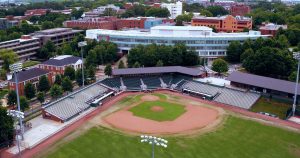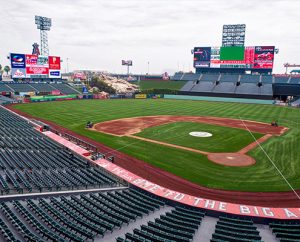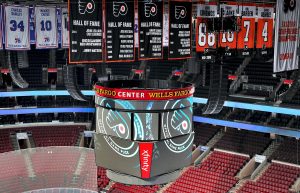Tech Focus: Venue Sound, Part 2 — New Builds Focus on Live Sound
System designers look to keep up with sports on television
Story Highlights
We are apparently nowhere near “peak stadium.” Recently completed and under-construction venues number in the dozens, and they are designed to help sports compete with the increasingly immersive experience of sports on television. The NFL Atlanta Falcons’ Mercedes-Benz Stadium offers so many HD monitors in the venue’s restaurants and clubs that patrons may prefer to watch the game at the bar. The same can be said of the premium lounges at Tottenham Hotspur’s new 61,000-seat £750 million stadium, which features the longest bar in the UK, heated seats with built-in USB ports, and a glass-walled tunnel so that fans can see the players before the game.
These new venues are also paying attention to sound, taking it to new levels and borrowing some techniques from broadcast sports. For instance, as part of a bid for the 2022 World Cup, Japan plans to embed microphones below the pitch to capture the sounds of every ball kick and tackle.
Here is a look at three of the newer venues in the U.S. and their live-sound solutions to give fans in the stands the best-sounding noise possible.
CLICK HERE for Tech Focus: Venue Sound, Part 1 — Louder, Clearer, Bigger (Bottom).
Wells Fargo Center Ups Its Game
The Wells Fargo Center hosts games by the NBA Philadelphia 76ers, NHL Philadelphia Flyers, and AFL Philadelphia Soul, and their fans are enjoying updated sound in the venue this year, thanks to $250 million in upgrades delivered by the arena’s “Transformation 2020” initiative.
Centerpiece of the venue’s renovation is a new L-Acoustics K2/K1-SB sound system, designed by consultant WJHW and installed by integrator Diversified. The system comprises two flown arrays of 12 K2 three-way, full-range enclosures covering each long side of the arena, plus four arrays of 13 K2 covering the ends and corners. Six arrays of four K1-SB subwoofers are flown in an end-fire configuration behind each K2 array to support low-end impact and offer enhanced LF directivity in the 20,000-seat venue. To optimize LFE performance, the subs are precisely spaced and time-aligned to maximize both forward directivity and rear rejection of low frequencies.
In addition, expandable AVB networking connectivity was implemented for the transmission of audio along with system control and monitoring.
Diversified designed the sound system to accommodate both the current needs of the arena and its future requirements. For instance, plans for a new scoreboard — touted by venue owner Comcast Spectacor as “the first-ever Kinetic 4K center-hung entertainment system” — have recently been announced, and the K2 system design and installation would have to provide for that future addition.
“Sports are being increasingly regarded as entertainment,” explains Justo Gutierrez, director, A/V and sound, Sports & Live Events Group, Diversified. “Consumers’ expectations are changing as a result. They want concert-level sound in the stadiums and arenas.”
Russ Chandler Stadium Aims To Be a Good Neighbor
Georgia Tech’s Yellow Jackets baseball team has posted numerous NCAA Division I conference championships and practices and plays all of its home games at Russ Chandler Stadium, a 4,000-plus–seat stadium originally built in 1930 and massively renovated in 2002. Located in Atlanta’s Midtown area, the stadium has the potential for noise complaints from nearby classroom buildings and businesses.

The sound system at Georgia Tech’s Russ Chandler Stadium in Midtown Atlanta is designed to keep the sound inside.
Taking the neighbors into consideration, Gainesville, GA-based A/V firm dB Integrations recently installed two Danley-based sound systems for Russ Chandler Stadium: for game day, one that includes a Danley SH96HO loudspeaker and a Danley BC415 subwoofer; for practices, one featuring a more modest Danley OS80 weatherized loudspeaker. Both rely on DSP pattern control to put sound where it needs to be and minimize it everywhere else.
The seats stretch from approximately first base to approximately third base, and a single Danley SH96HO mounted on an existing tower hits all of them perfectly with minimal spill above or to either side. The Danley BC415 subwoofer also provides significant low-frequency power and directivity, which again helps satisfy the close-quarters requirements for the stadium’s new system. Each of two Danley DNA 20k4 Pro amplifiers — one for the SH96HO and one for the BC415 —delivers four 5,000-W amplifier channels with comprehensive DSP and custom presets for the boxes. In the press box, four new Shure ULXD wireless receivers paired with handheld microphones feed an Allen & Heath SQ5, along with various playback devices.
“We were careful to build game-day and practice systems that would help the team avoid noise complaints,” explains Ronnie Stanford, director, sales and marketing, dB Integrations. “In addition, we designed and installed a whole new frontend in the press box, along with simple practice control from the home dugout.”
At Angel Stadium, Music for the Players
Angel Stadium of Anaheim, CA, now has a permanently installed field-level sound system to play music during pregame practices and warmups. According to Brad Fisher, senior account executive, Diversified, the demand for this came directly from the players: “The athletes raised their voices on this one. In the past, we’ve seen temporary systems rolled onto the field for pregame music. [But] throwing [sound] from the upper deck through the [main] PA just doesn’t give them the punch they want to hear on the field.”

At Angel Stadium of Anaheim, a field-level sound system plays music during pregame practices and warmups.
The venue now houses a 200,000-W combined d&b Audiotechnik and Nexo SA speaker system through 300 speakers and 50 subwoofers. A Yamaha CL3 mixing console and QSC QSYS processors provide control for the system, which, except for the announcer’s mic, is entirely digital. Two amplifier rooms with power, HVAC, and fiber connections were added to shorten wire lengths for improved performance to the extended seating sections.
Fisher notes that, while ever-larger in-venue video is important for fan engagement, so is the sound that is married to those pictures. “The quality of the synchronized audio is critical. The sound has to have a presence. It has to sound good. It can’t be an afterthought.”

